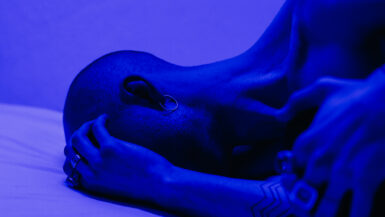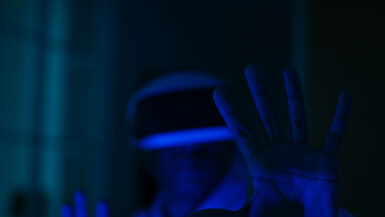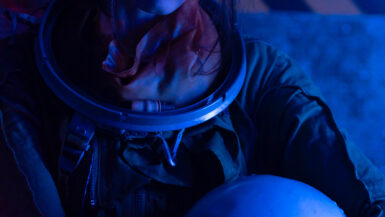In today’s fast-paced digital world, the impact of blue light on sleep and productivity has become a topic of growing interest and concern. The Relationship Between Blue Light and Melatonin Production delves into the intricate connections between these three elements to provide readers with a comprehensive understanding of how our modern lifestyle may be affecting our sleep patterns and overall performance. This article will explore the science behind blue light, its effect on our body’s natural sleep hormone, melatonin, and the potential consequences of prolonged exposure on our daily productivity. By examining the latest research and innovations in this field, we aim to equip our readers with the knowledge necessary to make informed decisions about their exposure to blue light, ultimately promoting a healthier and more productive lifestyle.
How Blue Light Affects Circadian Rhythms
Circadian rhythms, our body’s internal clock regulating the sleep-wake cycle, play a crucial role in determining the quality of our sleep and overall well-being. In this section, we delve into the impact of blue light on these rhythms, exploring the science behind this connection and offering practical solutions to mitigate its effects.
The Science Behind Blue Light and Circadian Rhythms
Blue light is a high-energy wavelength of light found in sunlight and emitted by most electronic devices, such as smartphones, tablets, and computer screens. While blue light is essential for regulating our alertness and cognitive function during the day, excessive exposure in the evening can have negative effects on our circadian rhythms.
The human eye contains specialized cells called intrinsically photosensitive retinal ganglion cells (ipRGCs), which are responsible for detecting blue light and sending signals to the brain’s suprachiasmatic nucleus (SCN). The SCN then regulates the release of melatonin, the hormone responsible for sleep. When blue light is detected, the SCN suppresses melatonin production, thereby keeping us awake and alert. However, this process can become disrupted when we are exposed to artificial blue light in the evening, leading to delayed or disrupted sleep.
Consequences of Disrupted Circadian Rhythms
When our circadian rhythms are thrown off balance due to excessive blue light exposure, it can result in a range of health and productivity issues. These include difficulty falling asleep, reduced sleep quality, and daytime drowsiness. In the long term, disrupted circadian rhythms have been linked to an increased risk of obesity, diabetes, cardiovascular disease, and mood disorders like depression and anxiety. Moreover, sleep deprivation can significantly affect our cognitive abilities, impairing memory, decision-making, and problem-solving skills, ultimately impacting our productivity and performance during the day.
Implementing a Blue Light-Free Evening Routine
To minimize the impact of blue light on circadian rhythms and promote healthier sleep, it is crucial to adopt a blue light-free evening routine. For tips and strategies, check out our guide on How to Create a Blue Light-Free Evening Routine. Some key steps include limiting screen time before bed, using blue light filtering apps, and introducing calming activities like reading or meditation into your nightly routine.
By understanding the relationship between blue light and circadian rhythms, we can make conscious choices to minimize its impact on our sleep and overall well-being. Ultimately, adopting healthier habits around blue light exposure can lead to better sleep, improved productivity, and a more balanced lifestyle.
Understanding Blue Light and Its Sources
In order to grasp the full implications of the relationship between blue light and melatonin production, it’s essential to first identify the primary sources of blue light and how they affect our daily lives. This section will explore the natural and artificial sources of blue light, as well as delve into the varying intensities of blue light emitted by different electronic devices.
Natural Sources: The Sun
The most significant and natural source of blue light is the sun. During daylight hours, blue light from the sun helps regulate our circadian rhythms, keeping us awake, alert, and focused. This natural exposure to blue light is essential for our bodies to maintain a healthy sleep-wake cycle. However, as society has evolved, our exposure to blue light has increased significantly due to artificial sources, which can disrupt our natural balance.
Artificial Sources: Electronic Devices and LED Lighting
The widespread use of electronic devices, such as smartphones, tablets, laptops, and televisions, has led to an increased exposure to artificial blue light. These devices emit varying levels of blue light depending on screen size, brightness settings, and usage time. Additionally, energy-efficient LED lights, found in many homes and workplaces, emit blue light that can further contribute to our daily exposure.
Measuring Blue Light Intensity: Lux Levels
The intensity of blue light is measured in lux, a unit that describes the amount of light perceived by the human eye. For reference, natural daylight typically ranges from 10,000 to 25,000 lux, while most indoor lighting falls between 100 and 500 lux. Electronic devices, such as smartphones and laptops, emit blue light at levels between 30 and 50 lux. It’s important to note that while the lux levels from devices are much lower than those from natural sunlight, the close proximity and prolonged use of these devices can still have a significant impact on melatonin production and sleep quality.
Setting Healthy Boundaries with Blue Light
Being mindful of our exposure to blue light can help mitigate its effects on melatonin production and promote a more balanced sleep-wake cycle. Some practical steps include taking breaks from electronic devices throughout the day, adjusting screen brightness and color temperature settings, and utilizing blue light filtering apps or screen protectors. Additionally, incorporating more natural light into our daily routines and creating a sleep-friendly environment can further support healthy melatonin levels.
By identifying the various sources of blue light and understanding the role they play in our daily lives, we can make more informed decisions about our exposure and ultimately support a healthier sleep-wake cycle. As a result, we can enhance our overall well-being and productivity.
Melatonin Production and Its Role in Sleep
Understanding the connection between blue light and melatonin production is crucial to grasp the full impact of our modern lifestyle on sleep quality and overall well-being. In this section, we will delve into the process of melatonin production, its relationship with sleep, and the factors that can influence melatonin levels in the body.
The Science Behind Melatonin Production
Melatonin, often referred to as the “sleep hormone”, is a naturally occurring compound produced by the pineal gland in the brain. Its primary function is to regulate the sleep-wake cycle by signaling the body when it’s time to sleep. Melatonin production is closely tied to the presence of light, with production levels increasing in response to darkness and decreasing in the presence of light.
The role of blue light in melatonin production is particularly significant, as it serves as a key trigger for the suppression of melatonin. When our eyes detect blue light, the aforementioned ipRGCs send signals to the SCN, which in turn inhibits melatonin production. This process is essential for maintaining alertness during daylight hours; however, it can become disrupted when we are exposed to artificial blue light at night.
Factors Affecting Melatonin Production
In addition to blue light exposure, there are several other factors that can influence melatonin production and subsequently impact sleep quality. These include:
1. Age: Melatonin production tends to decrease as we age, which can contribute to sleep disturbances commonly experienced by older adults.
2. Lifestyle: Shift work, frequent travel, and irregular sleep schedules can disrupt the body’s natural circadian rhythms, leading to imbalances in melatonin production.
3. Medications: Certain medications, such as beta-blockers, can interfere with melatonin production, potentially impacting sleep quality.
4. Medical conditions: Sleep disorders, such as insomnia or sleep apnea, can disrupt melatonin production and contribute to poor sleep quality.
Understanding the various factors that can influence melatonin production can help inform strategies for promoting healthy sleep patterns and overall well-being.
Supporting Healthy Melatonin Production for Better Sleep
To support healthy melatonin production and improve sleep quality, it is important to adopt habits that promote a balanced sleep-wake cycle. Here are some practical tips for fostering melatonin production:
1. Limit evening exposure to blue light: As discussed earlier, reducing artificial blue light exposure in the evening can help support natural melatonin production and improve sleep quality.
2. Establish a consistent sleep schedule: Going to bed and waking up at the same time each day can help regulate the body’s circadian rhythms and facilitate melatonin production.
3. Create a sleep-friendly environment: A dark, cool, and quiet bedroom can encourage the production of melatonin and support restful sleep.
4. Consider supplementation: In some cases, melatonin supplements may be helpful for individuals experiencing sleep disturbances due to factors such as shift work or jet lag. However, it is important to consult with a healthcare professional before starting any supplementation.
By taking proactive steps to support healthy melatonin production, we can improve sleep quality, enhance our overall well-being, and optimize our daily performance.
Practical Tips for Reducing Blue Light Exposure
As we continue to explore the relationship between blue light and melatonin production, it becomes increasingly evident that taking measures to reduce our exposure to blue light, particularly in the evening, can significantly improve our sleep quality and overall well-being. In this section, we will provide practical tips and strategies to help you minimize your blue light exposure, support healthy melatonin production, and enhance your sleep experience.
Establish Screen-Free Time Before Bed
One of the most effective ways to reduce blue light exposure is to establish a screen-free period before bedtime. Aim to disconnect from electronic devices such as smartphones, tablets, and laptops at least an hour before going to sleep. Instead, engage in relaxing activities such as reading a physical book, practicing meditation, or taking a warm bath to help signal to your brain that it’s time to wind down and prepare for rest.
Utilize Blue Light Filtering Apps and Screen Protectors
Several apps and screen protectors are available to help filter out blue light emitted from electronic devices. Blue light filtering apps, such as f.lux or Night Shift (for iOS devices), adjust the color temperature of your screen to emit warmer, less harmful light. Similarly, blue light screen protectors can be applied to your devices to block a significant percentage of harmful blue light emissions. These tools can be particularly beneficial for individuals who must use electronic devices in the evening due to work or other commitments.
Adjust Screen Brightness and Color Temperature Settings
Another simple yet effective strategy to minimize blue light exposure is to adjust your screen brightness and color temperature settings. Lowering the brightness on your devices, especially during evening hours, can help reduce the intensity of blue light emissions. Additionally, many devices now offer built-in settings to adjust the color temperature to warmer hues, which emit less blue light.
Opt for Warmer, Dimmable Lighting in Your Home
The lighting in your home can also contribute to blue light exposure. Opt for warmer, dimmable LED bulbs instead of cool white or daylight bulbs, which emit higher levels of blue light. Additionally, consider using lampshades or dimmer switches to reduce the intensity of light in your living spaces, particularly in the evening hours.
Incorporate More Natural Light into Your Daily Routine
Exposure to natural sunlight during the day can help regulate your circadian rhythms, promoting healthy melatonin production and improving sleep quality. Make an effort to spend time outdoors during daylight hours, or open your curtains and blinds to let in natural light while indoors. This practice not only helps support healthy melatonin levels but also provides a range of other health benefits, such as boosting mood and supporting vitamin D synthesis.
By implementing these practical tips for reducing blue light exposure, you can take a proactive approach to supporting healthy melatonin production and improving your sleep quality. As a result, you’ll be better equipped to navigate the demands of our modern, technology-driven world while prioritizing your overall health and well-being.
Sleep Disorders Linked to Blue Light Exposure
As we delve deeper into the relationship between blue light and melatonin production, it becomes crucial to explore the potential sleep disorders that may arise due to excessive exposure to blue light. In this section, we will discuss various sleep disorders linked to blue light exposure and provide insights into how mitigating this exposure can help alleviate these conditions and improve overall sleep quality.
Insomnia: Struggling to Fall Asleep or Stay Asleep
Insomnia, characterized by persistent difficulty falling asleep or staying asleep, is one of the most common sleep disorders related to blue light exposure. As previously discussed, exposure to blue light in the evening can suppress melatonin production, which in turn disrupts our natural sleep-wake cycle. This disruption can make it challenging for individuals to fall asleep or maintain restful sleep throughout the night. By reducing evening blue light exposure and implementing healthy sleep habits, individuals suffering from insomnia can support melatonin production and potentially improve their sleep quality.
Delayed Sleep Phase Syndrome: An Altered Sleep-Wake Cycle
Delayed Sleep Phase Syndrome (DSPS) is a circadian rhythm disorder where an individual’s sleep-wake cycle is delayed, causing them to fall asleep and wake up later than conventional sleep times. This condition may be exacerbated by excessive blue light exposure, particularly in the evening, as it can further delay the onset of melatonin production. Limiting blue light exposure and establishing a consistent sleep schedule can help those with DSPS adjust their sleep-wake cycle and achieve more restorative sleep.
Sleep Apnea: Interrupted Breathing During Sleep
Although sleep apnea is primarily characterized by interrupted breathing during sleep, research has suggested a possible link between blue light exposure and the severity of this condition. Some studies have found that individuals with sleep apnea who are exposed to blue light during the evening may experience a more significant disruption in their sleep patterns, leading to increased daytime sleepiness and reduced overall sleep quality. While further research is necessary to establish a direct connection, managing blue light exposure may potentially contribute to improved sleep quality for those with sleep apnea.
Restless Legs Syndrome: Uncontrollable Urge to Move the Legs
Restless Legs Syndrome (RLS) is a neurological sleep disorder characterized by an uncontrollable urge to move the legs, often resulting in disrupted sleep. While the primary cause of RLS is still unknown, some studies have suggested a link between blue light exposure and the severity of RLS symptoms. By reducing blue light exposure, particularly in the evening, individuals with RLS may experience fewer sleep disruptions and an overall improvement in sleep quality.
As we uncover the various sleep disorders associated with blue light exposure, it becomes evident that limiting our exposure to blue light, especially in the evening, can have a profound impact on our sleep quality and overall well-being. By being mindful of our exposure to blue light and implementing healthy sleep habits, we can better manage these sleep disorders and achieve more restorative, rejuvenating sleep.





Leave a reply